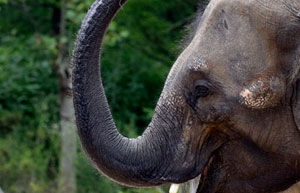How bats use a compass to find their way at night
Updated: 2014-07-30 10:10
(China Daily/Agencies)
|
||||||||
The windows were covered with light-polarizing filters - some of them oriented so the bats were exposed to "natural" scatter patterns and others tilted at a 90-degree angle.
The bats were offered a clear view of the horizon and the sun around dusk, when the scatter pattern is strongest, and then taken to two sites over 20 km away from where they were released on different nights, fitted with radio-transmitters.
Trying to make their way home, the two groups flew in different directions, with more of those exposed to the natural patterns approaching the target.
"The sunset could have been used as a cue to incorporate this information, but apparently bats ignored this and weighed the polarization cue higher," the study authors conclude.
It is not known, however, how the bats manage this feat. Other animals which use polarization patterns have special eye adaptations.
Animals rely on a range of sensory information for navigation - the position of the sun or stars, the Earth's magnetic field, smells, visual cues and light-scatter patterns.
These inputs have to be calibrated against one another for the most accurate result.
Bats, which are natural pest controllers, are in decline across Europe.
"Anything we can do to understand how they get about, how they move and navigate will be a step forward in helping to protect them," fellow researcher Richard Holland says in a statement.
|
|
|

 Star Stefanie Sun holds concert in Beijing
Star Stefanie Sun holds concert in Beijing
 Faye Wong's manager refutes star's drug rumors
Faye Wong's manager refutes star's drug rumors
 Lu Yi and daughter Bei Er pose for street snaps
Lu Yi and daughter Bei Er pose for street snaps
 Photoshoots of actress Li Xiaomeng
Photoshoots of actress Li Xiaomeng
 Council of Fashion Designers of America Awards
Council of Fashion Designers of America Awards
 Fan Bingbing, first Chinese actress in Barbie Hall of Fame
Fan Bingbing, first Chinese actress in Barbie Hall of Fame
 Awarding ceremony of 2014 hito Pop Music held in Taipei
Awarding ceremony of 2014 hito Pop Music held in Taipei
 Zhao Liying's photo shoot for Children's Day
Zhao Liying's photo shoot for Children's Day
Most Viewed
Editor's Picks

|

|

|

|

|

|
Today's Top News
Ex-security chief Zhou Yongkang under probe
Microsoft probed for monopoly
4 charged for murdering student
Prudence urged over solar dispute
Baidu developing 'self-driving' car
US visa delays likely to continue
McDonald's fishing for supplier
OSI group to fund food safety
US Weekly

|

|







